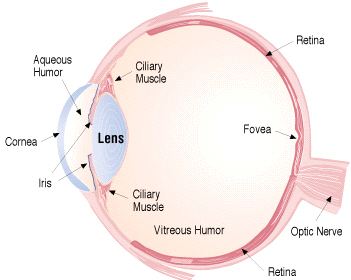The eye performs somewhat like a camera. The eye reacts to the scene and sends the appropriate nerve signals to the brain. In reality, the brain sees color, not the eye.
Light entering the eye lens is focused on the fovea. Five to seven million chromatic (color) sensitive cones in the retina of the eye are activated by the red, blue and green components of the incoming light. The red, blue and green cones send the appropriate signals to the brain, resulting in color perception. In addition, approximately one hundred and twenty million achromatic rods, which react only to lightness and darkness, send their lightness/darkness information to the brain. Color deficient vision is caused by a partial or complete absence of one of the types of cones. Varying individual levels and/or effectiveness of these cones are what causes individuals to see color somewhat differently.

Light Sources
As discussed earlier, the illuminating light source has a significant impact on an observer’s perception of the color of an object. Although it is one of the most commonly used viewing sources, daylight is one of the most uncontrolled and variable light sources!
Questions one might ask of “typical daylight” might be:
- What location (latitude) was selected for the measurements?
- What direction was the observer facing?
- What season of the year was selected?
- What month was selected?
- What time of day was selected?
- What was the weather?
The potential for differences in daylight powerfully suggest that controlled artificial light sources in light booths should be used for visual evaluations. Most artificial sources are quantified and are more likely to be consistent. The qualities of artificial sources are quantified and are designed to be consistent by specifying the relative energy at each wavelength, or Spectral Power Distribution.
Maintenance of these controlled sources is often a neglected activity. Proper maintenance and calibration must be accomplished to promote a consistent source.
ColorXpress™ Services uses calibrated and instrumented GretagMacbeth SpectraLight® light booths for visual assessments. These instruments contain controlled light sources representing D65 (Average North Sky Daylight), Horizon Daylight, Cool White Fluorescent and Incandescent illuminants.
Some light sources may contain Ultraviolet light. Certain samples will emit visible light in response to Ultraviolet light. It is important to realize that this phenomenon may exist and for ColorXpress™ Services and the customer to measure and assess samples similarly (same illuminants, UV component included or excluded.)